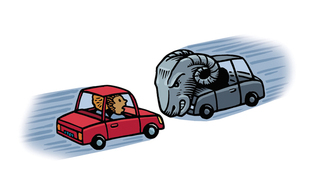 loading
loading
FindingsDodging the dataThe car brand most likely to kill occupants of other cars in an accident.  Gregory NemecView full imageDodge vehicles carry aggressive names: Challenger. Charger. Ram. It’s perhaps no coincidence, says Law School professor Ian Ayres ’81, ’86JD, that on safety, Dodge has one of the most aggressive records in the industry. By “aggressive,” he means having the “propensity to kill or injure someone in another vehicle.” When a Dodge crashes, people in the other vehicle are 2.2 times more likely to die than those in the Dodge, Ayres and law professor Amy Kapczynski ’03JD found in an analysis of US auto fatalities. In other words, Ayres says in an interview, “for every life inside the car that’s being saved, relative to the median, their cars are killing two people outside the car.” That’s the highest ratio of external to internal fatalities of any carmaker. (Ayres and Kapczynski calculated the ratios for their article “Innovation Sticks,” to be published in December in the University of Chicago Law Review.) A spokesman for FCA, Dodge’s manufacturer, responds: “The company takes seriously its commitment to public safety and designs its vehicles accordingly. All vehicles produced by FCA US LLC meet or exceed applicable safety standards.” Having a fleet that’s safer than average inside but more dangerous outside is “a fairly unusual trait” among auto companies, Ayres says, and it “raises interesting ethical questions, not just for Dodge and other laggard manufacturers but for consumers.” Academic literature on innovation “focuses almost exclusively on which type of carrot is the best” incentive, but “it occurred to us that you could have sticks”—financial penalties for low performers. (Other auto-related areas do: speed limits and fuel-efficiency standards, for example.) Fines for persistently high fatality averages would raise a new question for auto companies: “There are tons of other cars that are doing better than yours. Are there measures you could take to bring your fatality rate down?”
|
|
5 comments
-

Zachary Royce, 9:32pm March 19 2015 |  Flag as inappropriate
Flag as inappropriate
-

Paul Snare, 2:19pm April 15 2015 |  Flag as inappropriate
Flag as inappropriate
-

Liane Mark, 2:37pm April 15 2015 |  Flag as inappropriate
Flag as inappropriate
-

Christina Mason , 2:44pm April 15 2015 |  Flag as inappropriate
Flag as inappropriate
-

Martin E Cobern, 4:23pm April 15 2015 |  Flag as inappropriate
Flag as inappropriate
The comment period has expired.Ayres and Kapczynski--in leaping to the conclusion that their data suggests a design fault with Dodge vehicles, in labeling Dodge a "laggard manufacturer", and in recommending financial penalties for their "low performing" vehicles--seem to overlook an obvious (and much more probable) reason why Dodge vehicles have a higher kill ratio: that is, Dodge vehicles, which are not engineered substantially differently than their domestic competitors (e.g. Ford, Chevy), are targeted in their branding for a segment of the market which is in itself more likely to cause fatal accidents, i.e. young, male drivers with a rebellious streak. If you're an ole feller and you want a pickup truck, you'll probably choose the old standby Ford or Chevy. If you're a macho, young male--especially one that wants to prove he's "different"--you're more likely to purchase a Dodge pickup. As that young male Dodge pickup driver, you're also more likely to lift the suspension, mount oversize aggressive knobby tires, build up the motor, and generally drive like an a-hole. Sometimes academics can be so obtuse.
As a driver I like Dodge's numbers as a guide for future auto purchase. Ian & Amy uncovered data; Other car companies must improve their protection of passengers. Can they adopt some safety aspects of race cars, airplanes, and other collision situations?
This also assumes the fault of the crash is with the Dodge driver. My "mommymobile" is a Magnum!
As a young Mommy said to me years ago before buying an Enormous SUV: If I get into an accident I want to make sure my kids will be ok.
I privately noted to myself that her vehicle would crush whatever else was involved in an accident, but this wasn't something that she considered "her problem." Thus the push for ever bigger tanks to protect "ours" from everything else, no matter what the collateral damage is to "others." Sound like our economy in a nutshell?
There are two ways to protect the passengers in a car:
1) Provide a "crumple zone" to absorb the energy of the collision, and/or
2) Provide a rigid cage around the passengers, with restraints to prevent internal collision.
An ideal system combines the two. If a vehicle relies solely on the second, the collision energy is largely transferred to the other. Couple that with the greater mass of some of the Dodge trucks and SUVs and you have a recipe for "survival of the biggest," a totally selfish approach.